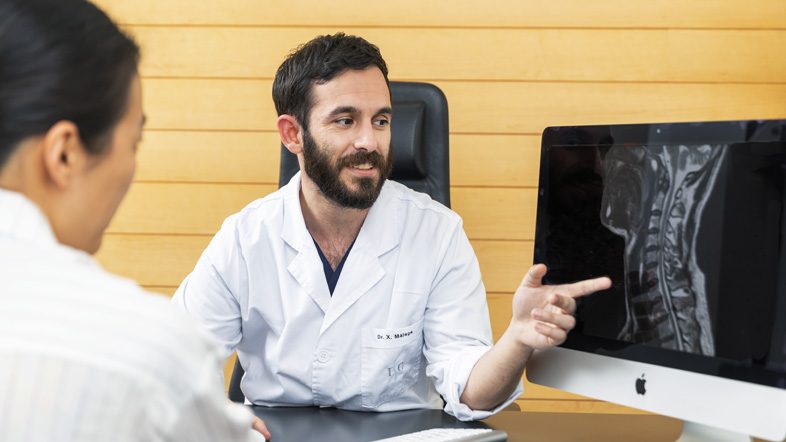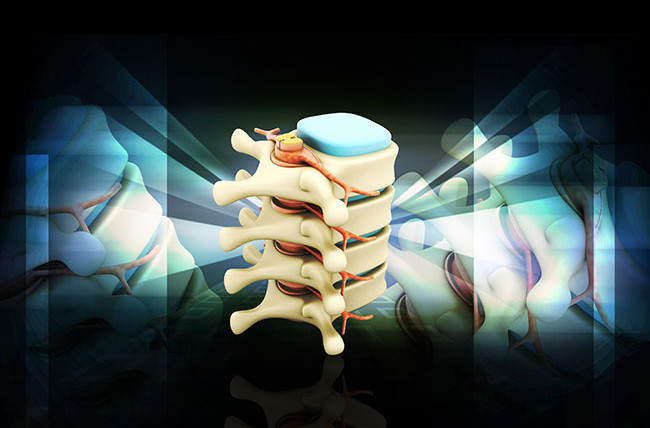At Instituto Clavel they have more than 20 years of experience in artificial disc replacement (ADR) surgeries. The high success rate of this technique allows our patients to increase their quality of life.
WHAT IS ADR SURGERY?
ADR surgery is a surgical procedure in which a degenerated intervertebral disc is removed and replaced with an artificial implant that mimics the function of a natural healthy disc. This procedure is used for patients suffering chronic pain due to degenerative cervical or lumbar disc disease, who have not found relief through conservative treatments.
At Instituto Clavel, we are pioneers in ADR, using the technique of anterior approach to the spine for the placement of the artificial disc. Thanks to this minimally invasive technique, we are able to avoid opening the back muscles, which in turn reduces postoperative pain and helps the patient achieve a faster and better recovery.
RESULTS OF THE SURGICAL TECHNIQUE
At Instituto Clavel we have more than 20 years of experience, having performed more than 1,500 successful ADR surgeries. This experience ensures that we can perform this type of operation safely and obtain the best results for our patients.
We have found that this technique is effective in significantly reducing pain in 90% of cases, resulting in a direct increase in your quality of life. In addition, approximately 70% of patients have been able to make a complete return to playing sports, a rate unheard of for other spinal surgeries.
WHAT DOES ADR SURGERY CONSIST OF?
Through experience and advances in innovation in recent years, the procedure for disc replacement surgery has improved markedly, making it the best option for those patients with lumbar and cervical disc degeneration.
The prostheses that are used today are highly resistant to wear and have a biomechanical behavior very similar to that of the natural disc. This means safer surgeries with better clinical results. Find out more about the types of surgery and the surgical process below.
TYPES OF ADR
Disc nucleus replacement
Replacement of the disc nucleus is not possible in the case of cervical discs due to their size and based on complications and the clinical results observed in the various studies that have been carried out over the years.
In the late 90’s and in the first decade of the 2000s, various proposals and designs of artificial lumbar disc nucleus implants were released.
In 2007, some of the doctors at Instituto Clavel participated in a multicenter study called Custom Implantable Medical Devices along with several European technology centers. We thought that if we were able to design a customizable disc nucleus prosthesis, there would be fewer cases of extrusion and subsidence, which are problems inherent in this type of prosthesis.
To do this, we searched for what could be the best possible material: a polyurethane with characteristics very similar to the lumbar disc. However, there turned out to be several difficulties when it came to implant it, and undoubtedly there would have been other complications due to the fact that the nucleus is not the only source of pain.
For this reason, and despite the attractiveness of the idea of replacing only the disc nucleus, at Instituto Clavel we believe that the recommended surgery in cases of lumbar and cervical degenerative disc disease is the total (or almost total) replacement of the disc.
Total disc replacement
With the total or almost total replacement of the disc we achieve the elimination of all the pain-causing agents: the degenerated nucleus, the degenerated and fissured ring, the synovertebral nerve endings and the degenerated endplate.
When this is done, the clinical result is usually very satisfactory, with good long term results in greater than 95% of cases. In addition, we are able to conserve the joint mobility.
Despite the fact that many surgeons continue to consider arthrodesis or spinal fusion as the surgery of choice, at Instituto Clavel we consider that ADR is the best option in cases of disc degeneration due to the advantages it presents and given the improvement in designs and materials that have taken place in recent years.
SURGICAL PROCEDURE
If you are considering ADR surgery as one of the treatment options to solve the problem of disc degeneration, you probably have many questions about the surgical procedure. So to answer your questions, in the following paragraphs we give you a detailed description of the steps involved in the operation.
At Instituto Clavel, in addition, we have the Preparation, Empowerment, and Recovery (PER) program for patients which will help you throughout the process, from getting prepared for the surgery and on through your postoperative recovery.
BEFORE THE SURGERY
Lumbar or cervical ADR surgery, like all surgeries, involves a detailed assessment of each case prior to the surgery. To have this done, patients should contact the Instituto Clavel to make an appointment at which they will be able to provide the specialist with all the necessary information.
In approximately one week after we have all your necessary information, you will receive the complete evaluation of your case from the specialist. In some cases, the doctor may tell you that some additional tests are needed before surgery. From this moment on, the preoperative preparation steps included in our PER program will be activated, which include specific protocols to reduce stress and make this stage of the process easier.
In the event that the patient has previously undergone any treatment (surgical or non-surgical) to treat the pain caused by the disc degeneration problem, it is important that you tell us so that the surgeon takes it into account before the intervention. Also, it is essential that you know your medical history and inform us of any medical conditions and any treatment that you are currently following.
DURING THE SURGERY
When the scheduled date for the operation arrives, the protocols of our PER program for surgery are activated, which aim to facilitate this stage of the process.
The patient is admitted to the hospital on the day of the operation. They will need to abstain from eating or drinking anything for at least 6 hours prior to the scheduled surgery time. While waiting for the operation, the patient will be in a hospital room, where he can be accompanied by his family and friends.
After this, he will be taken to the surgical area where the anesthetist will ask him some questions and then he will be asked to sign an informed consent of the possible risks related to anesthesia.
Next, the operation, which usually lasts about an hour, will be performed by the spine surgeon at the lumbar or cervical level. Although it depends on each case, as a guideline, when the operation involves more than one level, each extra level takes about fifteen minutes more.
When the surgery is over, the patient is awakened in the operating room and transferred to a recovery area, where he is monitored for about two hours before being taken to his hospital room.
The discharge from the hospital will depend on each patient’s case. On the average, the patient stays for one day for cervical arthroplasty, and three days for lumbar arthroplasty.
It is totally normal for the patient to feel discomfort in the area of the surgical incision or in the cervical or lumbar area, but this will subside over the next few days.
PATIENT POST-OPERATIVE AND RECOVERY PHASE
Recovery from ADR surgery, whether cervical or lumbar, is a gradual process, and it is normal for the patient to notice some discomfort. During the first week after surgery, we recommend that the patient take short walks, and exert no effort that causes stress. A follow-up visit is scheduled for the patient between 7 and 10 days after surgery. At this appointment the surgical wound is inspected, and the suture strips are removed, since no external stitches are applied in ADR surgery.
After that point, as a general recommendation, the patient should not exert any stressful effort or adopt bad postures during the first three months after surgery, and especially during the first month. They will be able to start swimming one month after surgery and run or ride a bicycle after the first 3 months.
After about 3 weeks, the patient can return to work if it does not require physical effort. For patients whose professional activity requires physical exertion, they can usually return to work about 6 weeks after the operation. In addition, we recommend that the patient have supervised rehabilitation sessions in a specialized physical therapy center.
Apart from the general recommendations, there are specific indications depending on whether the intervention was lumbar or cervical. At Instituto Clavel we do not recommend the use of lumbar belts on a routine basis. They are only indicated in some cases, for a short period of time, when the patient notices a certain abdominal distension.
On the other hand, we do recommend that patients who undergo cervical ADR wear a soft cervical collar – provided in the hospital, which can be removed for eating and sleeping – until the day of removal of the suture strips.
Of course, the recovery steps recommended will depend on each patient and will be made in a totally personalized way in each case. At Instituto Clavel we accompany the patient throughout the process. In addition, the staff continues to be available so that the patient can ask any questions about recovery through the usual channels such as telephone or email.
CONTROL OF POST-OPERATIVE PAIN
Postoperative discomfort or pain is normal, but at Instituto Clavel we do our best to ensure that this phase is as easy as possible for the patient.
During the hospital stay, the patient will receive painkillers intravenously to alleviate this post-operative discomfort.
Upon discharge, oral medication will be prescribed by the doctor according to each case. This will be gradually withdrawn on advice of the doctor at the following visits to Instituto Clavel.
The medication prescribed during and after hospital admission sufficiently covers the pain management needs of both cervical and lumbar ADR surgery.
REHABILITATION EXERCISES
After an ADR operation, the patient will need to perform a series of prescribed postoperative recovery exercises.
ARTIFICIAL DISCS
The artificial discs we use are elastomeric ones, all of them third generation. This means that the core is made of an elastomeric material (specifically, polyurethane) that mimics the mechanics of the natural disc in the best possible way. We use the cervical or lumbar M6 disc and the cervical or lumbar ESP disc, the former being less constrained than the latter. The model of implant chosen is based on the anatomy and mechanical requirements of the patient’s spine.
WHO IS A CANDIDATE FOR ADR SURGERY?
In general, the vast majority of patients with disc degeneration problems are candidates for ADR surgery. Also, in the case of athletes, it usually allows them to return to full activity and even competition within an estimated period of three months. In fact, at Instituto Clavel we are pleased to have seen how up to 70% of the patients operated on for lumbar ADR return to sports activity.
SIDE-EFFECTS OF THE SURGERY
ADR surgery has very few side-effects. Below are a few that we have seen over our 20 years of experience:
- In some cases, we have seen patients who have had residual pain or new low back pain that can be attributed to some biomechanical stress on the inter-pituitary joints, also known as facets. These cases improve with infiltrations or with radiofrequency treatments.
- We have observed a very few cases of the lumbar disc prosthesis sinking, especially in menopausal women over the age of 50. That’s why, in the case of women, for all patients over 40 or 50, we request a bone densitometry test prior to surgery to know the quality of their vertebrae.
- There have been some cases of extrusion or anterior displacement of the implant, all of them solved by reoperating and repositioning of the implant.
- We inform our male patients prior to surgery that there is a 0.5% risk of retrograde ejaculation, especially when the L5-S1 disc is operated on. However, in most cases it is resolved.


